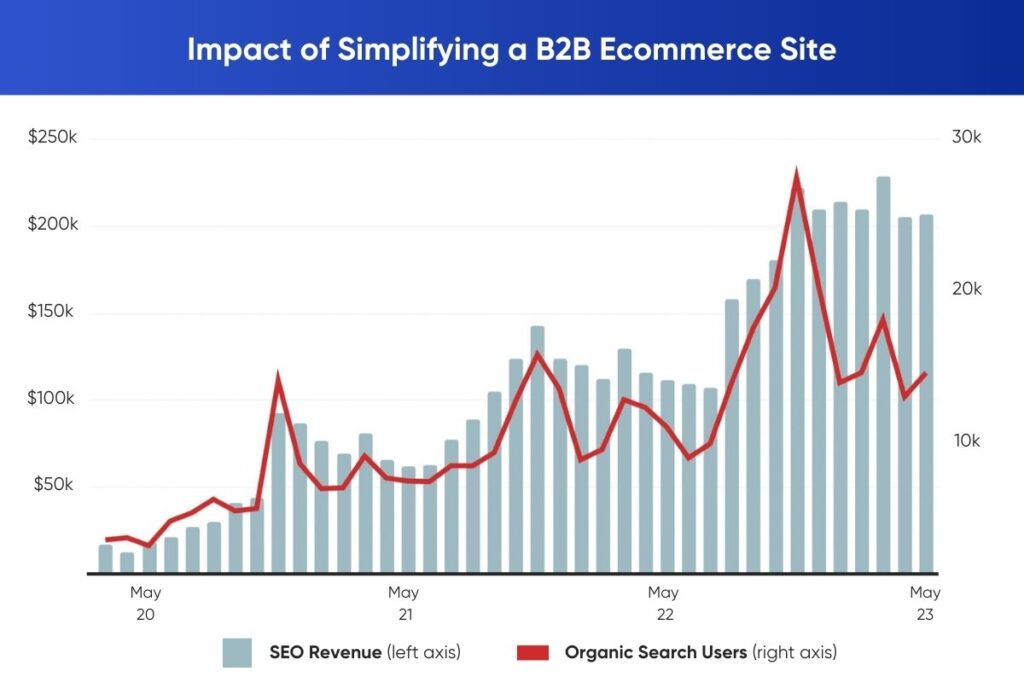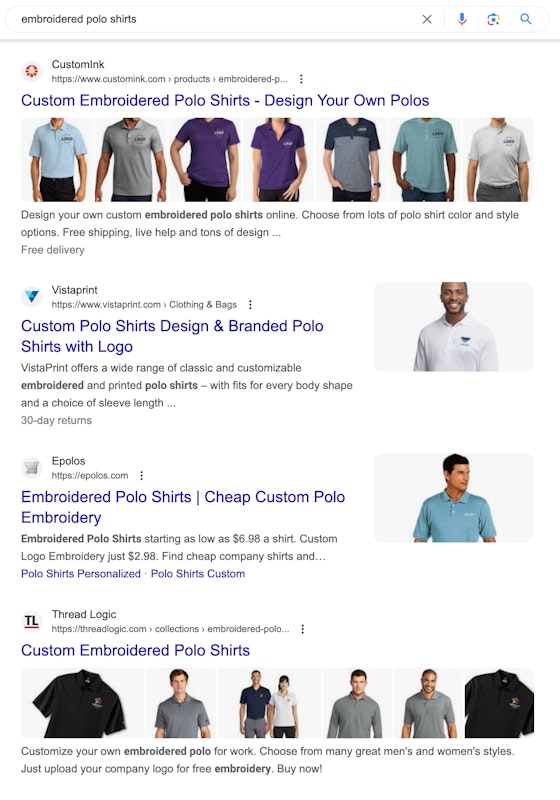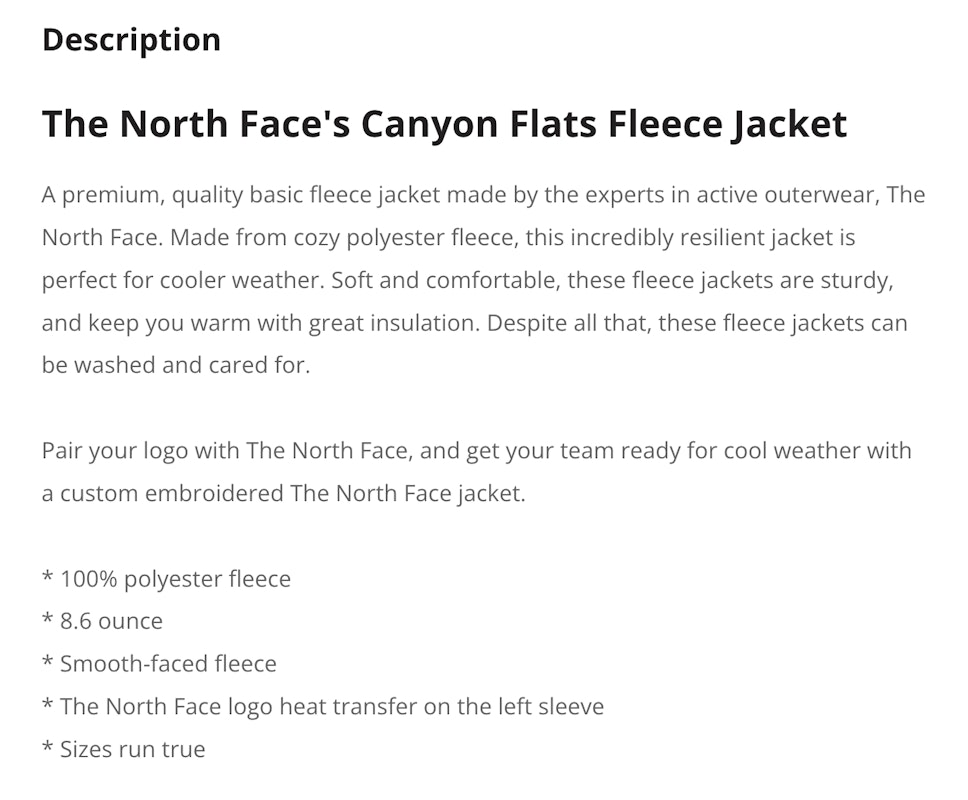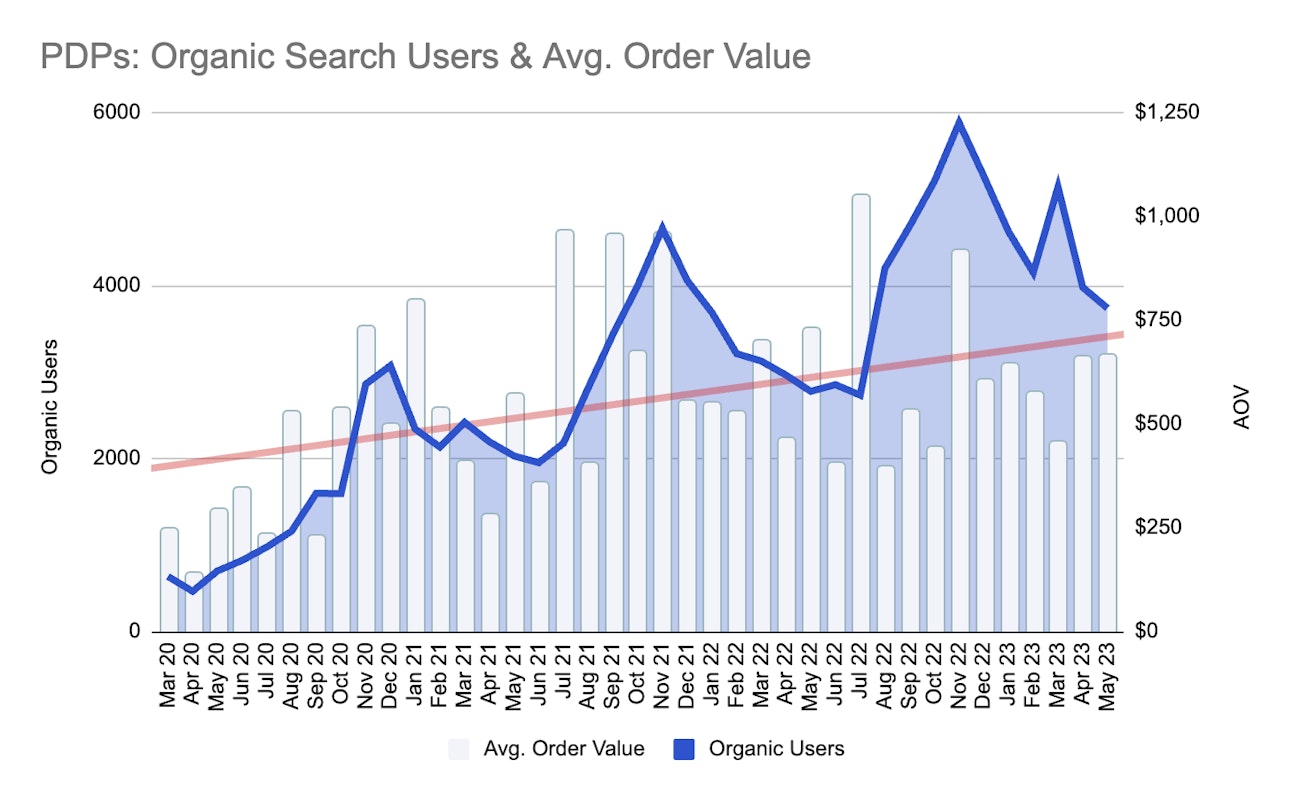Table of Contents
B2B ecommerce is complex. Unlike its B2C counterpart, the customer journey is often lengthy, involving multiple stakeholders in the buying process.
Trying to accommodate all of the possible buying scenarios through your site architecture and SEO strategy can lead to a user experience that's even more complex than the buyer journey. What do you get as a result? Some seriously disappointing results.
In this article, we'll show you how streamlining your approach to B2B ecommerce SEO can lead to massive growth. We'll walk you through the strategy we developed for Thread Logic, a B2B custom logo embroidered apparel company, that resulted in 543% SEO revenue growth and 1,274% organic traffic growth.

The Challenges of B2B Ecommerce SEO
As if ecommerce SEO wasn't challenging enough, it's even harder to implement successfully in the B2B space. Here's why:
Long Buying Cycles
B2B ecommerce transactions often include multiple stakeholders and several stages of approval. This can lead to long decision-making periods that make channel attribution difficult.
Difficulty Differentiating
A lot of B2B ecommerce retailers run up against competitors that carry a similar assortment of products. Those product pages are often populated with manufacturer's descriptions. That content duplication can suppress the SEO performance of whomever the Google Gods deem not worthy of the top ranking positions.
Service Layer Complexity
Many B2B ecommerce companies don't just sell products but also have a service component. Those services may help customers with technical questions, product customization, and product adoption.
Or, they may exist solely to build a business relationship and influence repeat purchases as a managed customer account. So, at some point, an online transaction may move to become an offline one.

No orders are fulfilled by Thread Logic without some human intervention
The approach we took with Thread Logic acknowledged these challenges and helped us get the buy-in we required to drive serious SEO growth. Here's how we did it:
1. Understand Customer Behavior with Keyword Data & Stakeholder Conversations
You can extrapolate this point to just about any industry, but it's especially true in B2B ecommerce. You're not going to win by having the same site experience and content as your competitors.
But, how do you begin to differentiate? By paying closer attention to the needs of your customers than everyone else.
Use keyword data to understand buying tendencies
How people search, and in what volume, can tell you a lot about how your customers prefer to shop. That information can help you understand if your site experience is best serving the customer journey.
One insight we gleaned from Thread Logic's keyword research was that people rarely searched for gender-specific custom logo embroidered apparel. This seemed logical since most B2B customers would be buying on behalf of a group made up of men and women.
| Keyword | Volume |
| embroidered polo shirts | 2,400 |
| men’s embroidered polo shirts | 70 |
| women’s embroidered polo shirts | 50 |
However, Thread Logic's site architecture (and that of many of their competitors) was segmented into Men's and Women's categories, similar to a B2C apparel company. As a result, they were nowhere to be found for keywords that often had 20-30x the search volume as their "men's" and "women's" counterparts.
Sales & CX people are a goldmine for SEO insights
Typically, there's nobody closer to customers than a company's sales and customer service teams. While the marketing department may think they have the upper hand, it's these folks who are on the ground level for insightful customer conversations, like:
- Confusion or friction arising from the site experience
- Frequently asked questions about the products or process
- Obstacles they're encountering along the path to purchase
- Reasons why they might choose to buy from a competitor
It's not unusual for us to walk away from a stakeholder interview with a client's Sales or CX team with 6 months of content ideas to pursue. Thread Logic was no different.
In addition to having a list of highly-relevant content ideas, we confirmed that indeed most of their orders included both men's and women's products. This validated our earlier keyword research finding.
2. Align Your Site Experience with the Customer Journey
With insights in hand & client buy-in earned, it's time to activate your recommendations. For changes to a site's architecture, you need to give yourself plenty of time for planning. All too often, changes to a site's architecture result in some issues being fixed while spawning new ones that could have been foreseen.
Be sure you check these boxes before any site work begins:
- Identify instances of duplication or cannibalization: Not only do these issues contribute to a poor user experience, but they're highly problematic for SEO performance. Map out your site's pages and target keywords to address all opportunities for content consolidation.
- Build a redirect map: You don't want your site restructure to leave behind a wake of broken links, ugly URL slugs, and dead SEO equity. Get your redirect map ready before any changes are deployed.
- Prepare new content in advance: Don't launch a half-baked solution. Know where you'll need new content & figure out how you'll repurpose content from pages that are being consolidated or retired. Important content elements include:
- Page titles & meta descriptions
- Headings
- Body content
- Target keyword(s)
Product Category Consolidation
For Thread Logic, we consolidated most of their Men's, Women's and Unisex product categories down to one page per category. Customers who need to be able to filter by Men's & Women's products would now be able to do so using the faceted navigation.
The SEO impact of these improvements to Thread Logic's site architecture was immediate and lasting. The organic visibility of their category pages has grown from 150 first-page keyword rankings to over 3,800! What's even cooler is that this was accomplished by reducing the number of category pages on their website.

Getting back to our earlier example of custom logo embroidered polos, their ranking for this highly-competitive keyword improved from #30 to a top-4 position. Now they sit among some of the largest players in the custom logo embroidered apparel industry.

SEO strategies can often fall into the trap of "more is more". More content means more rankings which means more traffic and conversions. But time and time again, we've found success in simplifying and streamlining site experiences to drive SEO growth.
3. Enrich Category & Product Page Content
Now that you've built a simpler, more intuitive site experience, your work is far from done. Page-level optimizations will make or break your opportunity to earn and maintain top keyword positions.
Counter to the performance of many B2B and B2C ecommerce websites, we found that Thread Logic's category pages had a 73% higher conversion rate and 14% higher AOV than their product pages. Why?
Most customers know they want, say, a custom logo embroidered polo, but they don't know which brand or which product specifically. Many of the biggest apparel brands and products in the promotional product space fly largely under the radar. Customers need guidance to get to the right product.
Thread Logic already knew this. For years, they've intentionally kept a smaller catalog size of only the highest quality and most popular styles to reduce decision fatigue. We wanted content on key pages to further support this goal.
- Lower the barrier to conversion: Ordering custom logo embroidered apparel involves several steps and, sometimes, additional fees and other buying considerations. To make things more confusing, every company in this space does it differently. To counter the confusion, we created content that reinforced Thread Logic's straightforward buying process.

- Differentiate from the competition: If you've ever shopped for promotional apparel, you've probably experienced deja vu. Most product pages feature the same manufacturer descriptions repeated across every company's website. We saw an opportunity to write unique content for top-performing products that would engage customers and eliminate duplication to achieve better rankings.

Thread Logic's unique, engaging product description as compared to three other competitors (below)
| Competitor 1 | Competitor 2 | Competitor 3 |
 |  |  |
Similar to their category pages, Thread Logic's product pages have since significant SEO growth in our 3 years partnered together. Monthly traffic has increased by 8x and the AOV of product page converters has increased by 2.5x.

The Thread Logic team, of course, deserves a ton of credit for these improvements. In the last few years, they've committed a lot of time, effort, and money toward improving their shopping experience. Their ordering process is best in class.
4. Answer Customer FAQs and Address Pain Points
With an improved site experience and an ever-decreasing list of ecommerce pages to optimize, you might ask, "Where do I go from here?"
Expand beyond transactional keywords and look to capture potential customers as they navigate the buying process. What questions are they asking to inform their purchase decision? What pain points are they experiencing, or hoping to avoid?
With a well-researched content strategy, you can be positioned to offer timely guidance that creates a positive brand impression or, better yet, influences a would-be customer to buy from you.
For Thread Logic, publishing content on topics like a custom logo embroidery pricing guide and a round-up of their favorite hats for custom logo embroidery has meant that their blog has become a major source of organic traffic and a contributor to transactions.

In the last 3 months, 6.5% of SEO-driven transactions have included a blog touchpoint. These users convert at a rate that's 22x higher than the channel average. For this reason, we're continuing to invest in content that meets potential customers early and often along the path to conversion.
Take a Step Back to Move Forward
Sometimes, the path to growth involves taking a step back before making moves forward. Thread Logic's incredible SEO success would not have been possible without first simplifying their site experience. If you find yourself in a similar position as Thread Logic was 3 years ago, reach out for an introductory call. We'd like to explore if our "less is more" approach is right for you.

